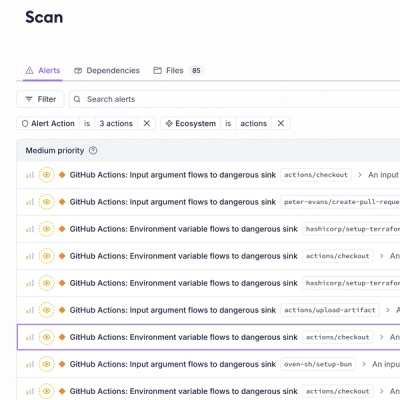
Product
Introducing Socket Firewall Enterprise: Flexible, Configurable Protection for Modern Package Ecosystems
Socket Firewall Enterprise is now available with flexible deployment, configurable policies, and expanded language support.
Helper utilities for the Figma Plugin API.
yarn add figments
Abstracts away the message-passing needed to make network requests from UI code, and lets you call fetch in the UI thread just as you do in the plugin main thread.
To use Fetch, first enable the FetchController in your main plugin thread:
/* main.ts */
import { Fetch } from "figments";
(function main() {
// Initialize the FetchController (a static singleton) and enable it.
Fetch.controller.enable();
figma.ui.on("message", (msg, props) => {
// All your other message handlers
});
figma.showUI(__html__);
})();
Then in your client code, construct a FetchClient and enable it too. You can now make network requests directly from your UI thread:
/* ui.ts */
import { Fetch } from "figments";
// Create (and enable) a FetchClient.
const client = Fetch.createClient().enable();
// The UI-side API works exactly like the native `fetch` API:
const res = await client.fetch("https://httpbin.org/post", {
method: "POST",
headers: {
Accept: "application/json",
Cookie: "baz=0; qux=1",
},
body: JSON.stringify({ foo: 42, bar: false }),
});
// res ->
// {
// "type": "cors",
// "ok": true,
// "status": 200,
// "statusText": "",
// "data": {
// "args": {},
// "headers": {
// "Accept": "application/json",
// ...
// },
// "json": {
// "bar": false,
// "foo": 42
// },
// ...
// "url": "https://httpbin.org/post"
// }
// }
NOTE:
Fetch.createClient()is just syntax sugar fornew FetchClient(). Theenable()and.disable()methods returnthis, so it's often simpler to just create and enable a client in one line.
The singleton main thread controller that actually calls the fetch API and handles messaging with the client. Same as Fetch.controller.
Methods
static enable(): void: Enable the controller, allowing it to listen for and perform fetch requests from the client, and return them to the client.static disable(): void: Disable the controller, causing it to stop listening for requests.The UI thread client that allows you to interact with the fetch API. You can create as many clients as you like.
Methods
constructor(): FetchClient: Create a client.enable(): void: Enable the client, allowing it to make network requests.disable(): void: Disable the client, causing it to ignore any pending requests.async fetch<T>(url: string, init?: FetchOptions): Promise<FetchResponseUnwrapped<T>>: Make a network requests as you are used to with the fetch API.NOTE: Since methods cannot be serialized over the plugin/UI boundary, the controller attempts
res.json(), followed byres.text(), setting the result to thedataproperty of the response, before returning it to the client.
// A serializable form of Figma's FetchResponse
export type FetchResponseUnwrapped<T = unknown> = {
headersObject?: { [name: string]: string };
ok: boolean;
redirected?: boolean;
status: number;
statusText: string;
type: string;
url: string;
data: T;
};
Abstracts away the message-passing needed to access clientStorage from UI code and lets you write code in the UI thread just as you do in the plugin thread, in addition to some other cool features for dealing with persisted data.
Using Figma's clientStorage API from UIs can be cumbersome – the UI thread can't talk directly to the storage, and we have to rely on event handlers and emitters on to do anything across the plugin/UI boundary. This usually involves a fair bit of boilerplate, and forces you to use synchronous code.
This module uses "channels" to handle all of the messaging between UI and plugin threads, allowing you to write async functions that set and return values to and from storage. Messages are scoped to their channel, meaning you will only subscribe to the data you want, and can even observe specific values in storage to watch them for changes.
To set up a storage channel, first construct a StorageController in your main plugin thread, give it a name, and enable it:
/* main.ts */
import { Storage } from "figments";
(function main() {
// Create a StorageController, providing an optional channel name.
// Omitting the name will create a channel that listens for all StorageMessages.
const controller = Storage.createController("channel_name");
// Controllers will only listen for messages when enabled.
controller.enable();
figma.ui.on("message", (msg, props) => {
// All your other message handlers
});
figma.showUI(__html__);
})();
Then in your client code, construct a StorageClient with the same channel name, and enable it too. You can now read and write values to storage directly from your UI thread:
/* ui.ts */
import { Storage } from "figments";
// Create (and enable) a StorageClient with the same channel name as the controller.
// The channel name determines what events from plugin code this client will respond to.
const client = Storage.createClient("channel_name").enable();
// The UI-side API works exactly like the native Figma `clientStorage` API:
const data = await client.getAsync("some_key");
await client.setAsync("other_key", { foo: 42, bar: false });
NOTE:
Storage.createClient("channel_name")is just syntax sugar fornew StorageClient("channel_name"), and the same applies tocreateController. Theenable()and.disable()methods returnthis, so it's often simpler to just create and enable a client or controller in one line.
In addition to reading and writing values directly, you can also observe whenever certain values (or any value) is updated by anyone on the channel, useful for adding reactivity when they are read and written from different places, or if you need your code to be synchronous or fire-and-forget.
import { Storage, StorageMethod } from "figments";
const clientA = Storage.createClient("my_channel").enable();
// Observe all changes on "my_channel", and log to the console
// whenever "power_level" is updated or removed.
clientA.observe(["power_level"], (event) => {
const { method, key, value } = event.data.pluginMessage;
switch (method) {
case StorageMethod.SET:
case StorageMethod.DELETE:
console.log({ [key]: value });
break;
default:
return;
}
});
// When any client writes to this key, on "my_channel", the first client is notified.
const clientB = Storage.createClient("my_channel").enable();
clientB.setAsync("power_level", 9000);
// LOG: { power_level: 9000 }
NOTE: You can observe all keys on this channel by passing
"*"as the first argument instead of an array of keys.
The main thread controller that actually talks to the storage device. You should only ever register one controller per channel name, or use a single controller with no channel name specified.
Methods
constructor(channel?: string): StorageController: Create a new controller.enable(): void: Enable the channel, allowing it to listen for and service requests from the client.disable(): void: Disable the channel, causing it to stop listening for requests.Fields
channel: string | undefined: The controller's channel name, if present.The UI thread client that allows you to interact with storage. You can have as many clients per channel as you like. Omitting the channel name will allow it to observe changes to all values in storage.
Methods
constructor(channel?: string, observers?: [ObserverKeys, StorageListener][]): StorageClient: Create a new client. Observers may be added for convenience during initialization to watch for changes to specific keys on this channel. Observers added this way cannot beenable(): void: Enable the client, allowing it to send and receive storage requests to the controller.disable(): void: Disable the client, causing it to stop listening for responses.getAsync<T>(key: string): Promise<T | null>: Get the value for key from storage.setAsync<T>(key: string, value: T): Promise<void>: Set key to value in storage.deleteAsync<T>(key: string): Promise<void>: Delete the entry for key from storage.keysAsync(): Promise<string[]>: Get all stored keys for this plugin.Fields
channel: string | undefined: The client's channel name, if present.FAQs
Helper utilities for the Figma Plugin API
The npm package figments receives a total of 1 weekly downloads. As such, figments popularity was classified as not popular.
We found that figments demonstrated a not healthy version release cadence and project activity because the last version was released a year ago. It has 1 open source maintainer collaborating on the project.
Did you know?

Socket for GitHub automatically highlights issues in each pull request and monitors the health of all your open source dependencies. Discover the contents of your packages and block harmful activity before you install or update your dependencies.

Product
Socket Firewall Enterprise is now available with flexible deployment, configurable policies, and expanded language support.

Security News
Open source dashboard CNAPulse tracks CVE Numbering Authorities’ publishing activity, highlighting trends and transparency across the CVE ecosystem.

Product
Detect malware, unsafe data flows, and license issues in GitHub Actions with Socket’s new workflow scanning support.